Examining Child Labour Issues in Modern Supply Chains
VerifiedAdded on 2023/06/18
|6
|1324
|394
Report
AI Summary
This report examines the pervasive issue of child labor within global supply chains, particularly in lower tiers such as raw material extraction and agriculture. It highlights the challenges in ensuring due diligence, visibility, and traceability due to the scale and complexity of these networks. The report references statistics from the International Labor Organization and discusses contributing factors like poverty, societal norms, and lack of educational opportunities. It also mentions the Modern Slavery Act 2015 and the Fair Labor Standards Act as efforts to combat child labor. The report concludes with recommendations for organizations, including reviewing natural laws, stopping the employment of underage children, engaging consumers, and formulating strategies to improve economic conditions and education. Ultimately, the report emphasizes the importance of reducing child labor to promote education and development, advocating for a collaborative approach involving governments, businesses, and communities. Desklib offers similar solved assignments and past papers for students.
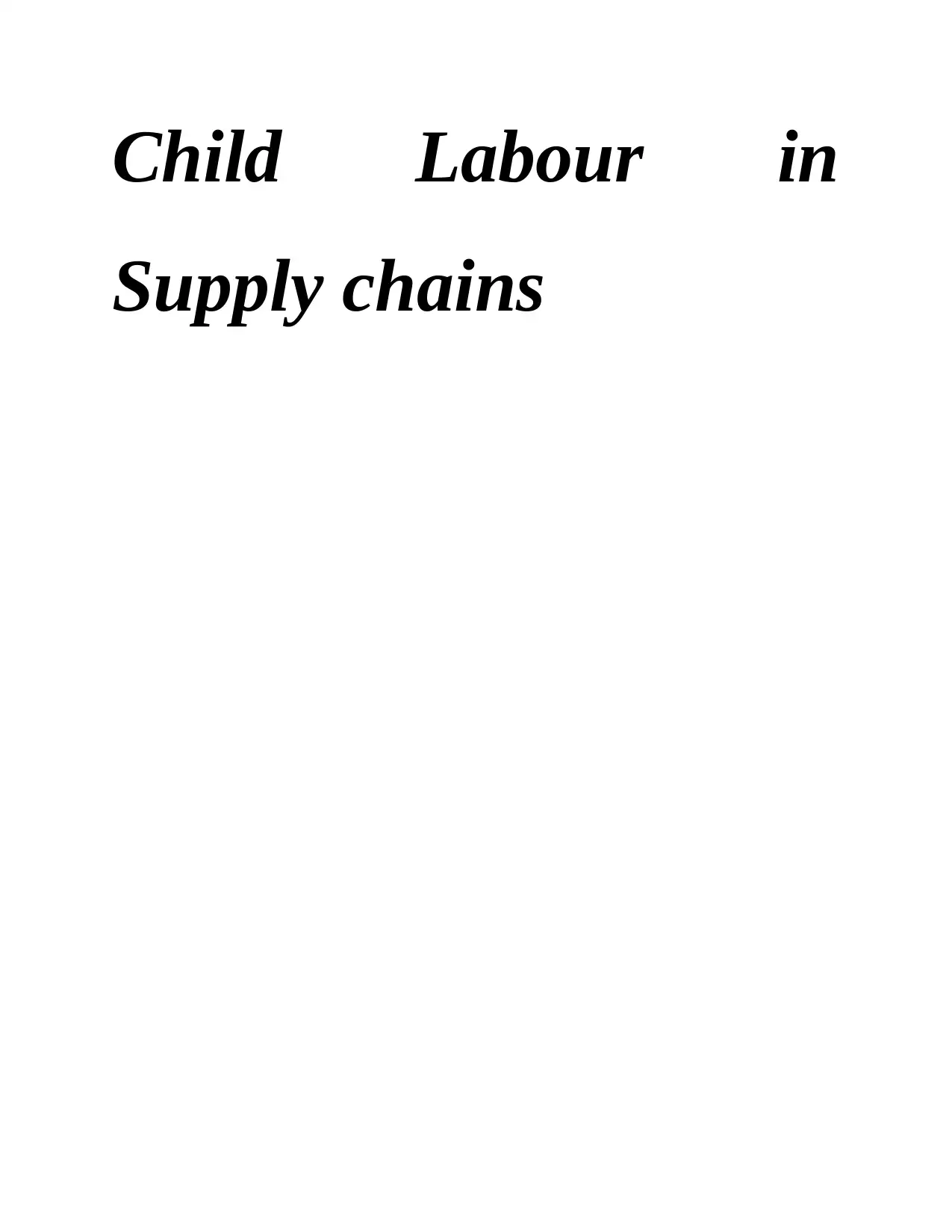
Child Labour in
Supply chains
Supply chains
Paraphrase This Document
Need a fresh take? Get an instant paraphrase of this document with our AI Paraphraser
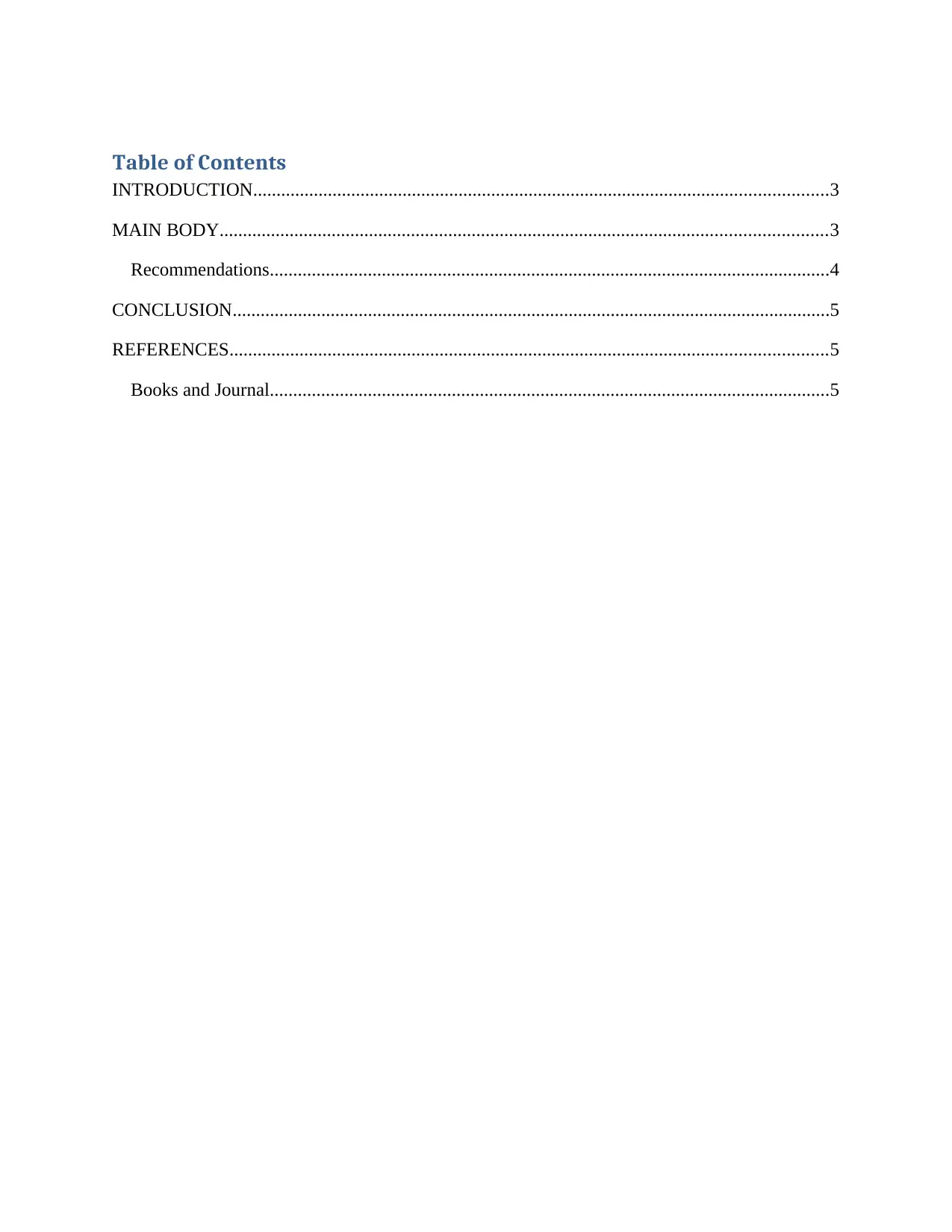
Table of Contents
INTRODUCTION...........................................................................................................................3
MAIN BODY..................................................................................................................................3
Recommendations........................................................................................................................4
CONCLUSION................................................................................................................................5
REFERENCES................................................................................................................................5
Books and Journal........................................................................................................................5
INTRODUCTION...........................................................................................................................3
MAIN BODY..................................................................................................................................3
Recommendations........................................................................................................................4
CONCLUSION................................................................................................................................5
REFERENCES................................................................................................................................5
Books and Journal........................................................................................................................5
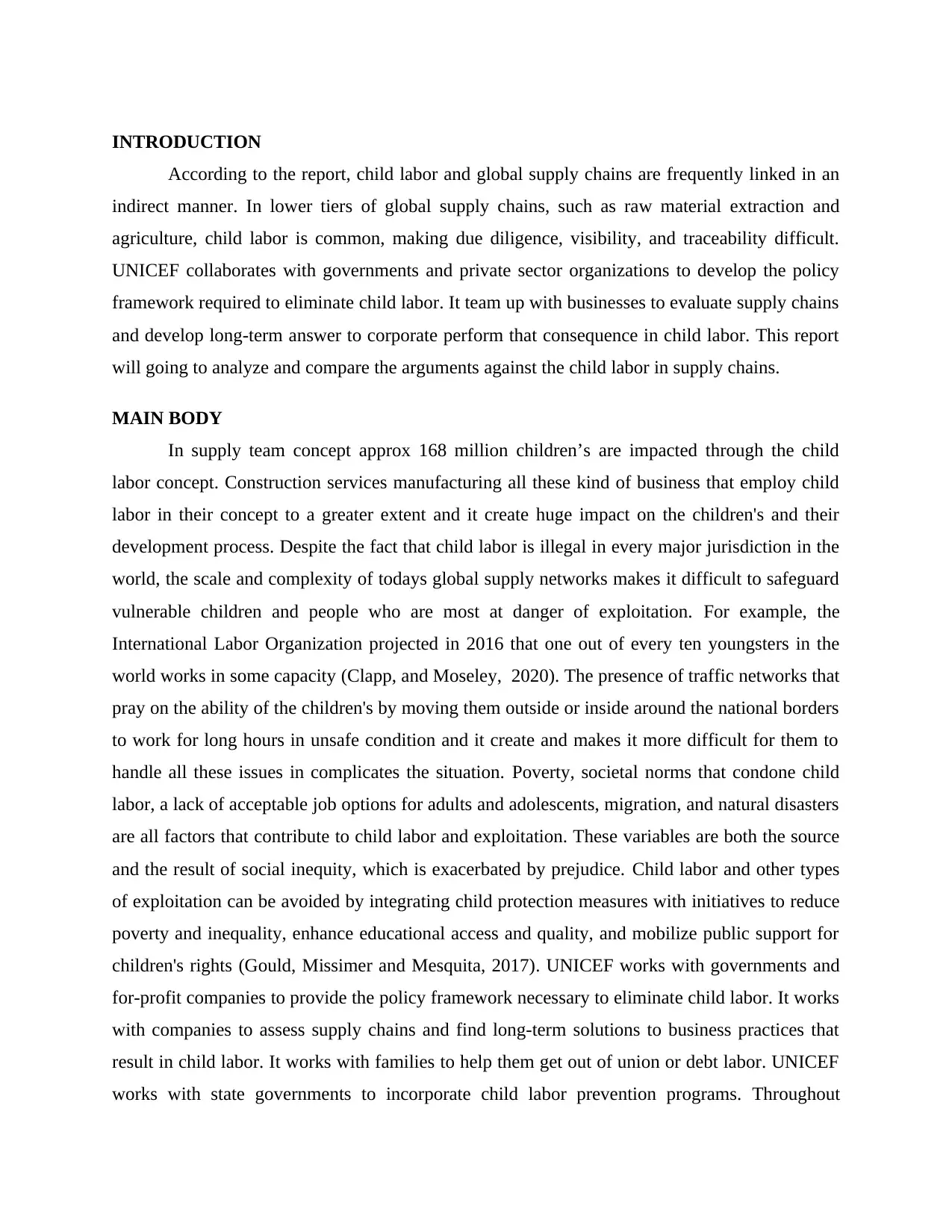
INTRODUCTION
According to the report, child labor and global supply chains are frequently linked in an
indirect manner. In lower tiers of global supply chains, such as raw material extraction and
agriculture, child labor is common, making due diligence, visibility, and traceability difficult.
UNICEF collaborates with governments and private sector organizations to develop the policy
framework required to eliminate child labor. It team up with businesses to evaluate supply chains
and develop long-term answer to corporate perform that consequence in child labor. This report
will going to analyze and compare the arguments against the child labor in supply chains.
MAIN BODY
In supply team concept approx 168 million children’s are impacted through the child
labor concept. Construction services manufacturing all these kind of business that employ child
labor in their concept to a greater extent and it create huge impact on the children's and their
development process. Despite the fact that child labor is illegal in every major jurisdiction in the
world, the scale and complexity of todays global supply networks makes it difficult to safeguard
vulnerable children and people who are most at danger of exploitation. For example, the
International Labor Organization projected in 2016 that one out of every ten youngsters in the
world works in some capacity (Clapp, and Moseley, 2020). The presence of traffic networks that
pray on the ability of the children's by moving them outside or inside around the national borders
to work for long hours in unsafe condition and it create and makes it more difficult for them to
handle all these issues in complicates the situation. Poverty, societal norms that condone child
labor, a lack of acceptable job options for adults and adolescents, migration, and natural disasters
are all factors that contribute to child labor and exploitation. These variables are both the source
and the result of social inequity, which is exacerbated by prejudice. Child labor and other types
of exploitation can be avoided by integrating child protection measures with initiatives to reduce
poverty and inequality, enhance educational access and quality, and mobilize public support for
children's rights (Gould, Missimer and Mesquita, 2017). UNICEF works with governments and
for-profit companies to provide the policy framework necessary to eliminate child labor. It works
with companies to assess supply chains and find long-term solutions to business practices that
result in child labor. It works with families to help them get out of union or debt labor. UNICEF
works with state governments to incorporate child labor prevention programs. Throughout
According to the report, child labor and global supply chains are frequently linked in an
indirect manner. In lower tiers of global supply chains, such as raw material extraction and
agriculture, child labor is common, making due diligence, visibility, and traceability difficult.
UNICEF collaborates with governments and private sector organizations to develop the policy
framework required to eliminate child labor. It team up with businesses to evaluate supply chains
and develop long-term answer to corporate perform that consequence in child labor. This report
will going to analyze and compare the arguments against the child labor in supply chains.
MAIN BODY
In supply team concept approx 168 million children’s are impacted through the child
labor concept. Construction services manufacturing all these kind of business that employ child
labor in their concept to a greater extent and it create huge impact on the children's and their
development process. Despite the fact that child labor is illegal in every major jurisdiction in the
world, the scale and complexity of todays global supply networks makes it difficult to safeguard
vulnerable children and people who are most at danger of exploitation. For example, the
International Labor Organization projected in 2016 that one out of every ten youngsters in the
world works in some capacity (Clapp, and Moseley, 2020). The presence of traffic networks that
pray on the ability of the children's by moving them outside or inside around the national borders
to work for long hours in unsafe condition and it create and makes it more difficult for them to
handle all these issues in complicates the situation. Poverty, societal norms that condone child
labor, a lack of acceptable job options for adults and adolescents, migration, and natural disasters
are all factors that contribute to child labor and exploitation. These variables are both the source
and the result of social inequity, which is exacerbated by prejudice. Child labor and other types
of exploitation can be avoided by integrating child protection measures with initiatives to reduce
poverty and inequality, enhance educational access and quality, and mobilize public support for
children's rights (Gould, Missimer and Mesquita, 2017). UNICEF works with governments and
for-profit companies to provide the policy framework necessary to eliminate child labor. It works
with companies to assess supply chains and find long-term solutions to business practices that
result in child labor. It works with families to help them get out of union or debt labor. UNICEF
works with state governments to incorporate child labor prevention programs. Throughout
⊘ This is a preview!⊘
Do you want full access?
Subscribe today to unlock all pages.

Trusted by 1+ million students worldwide
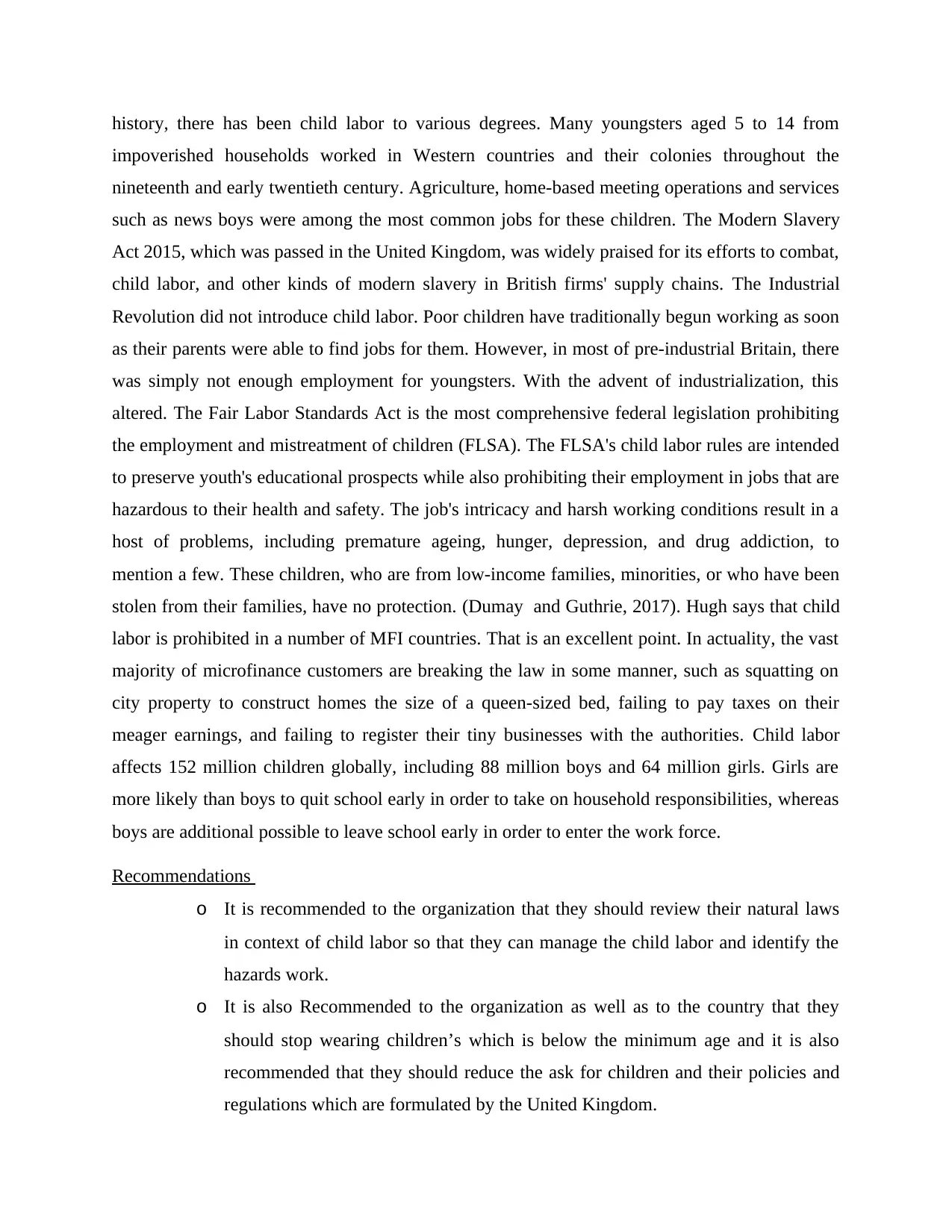
history, there has been child labor to various degrees. Many youngsters aged 5 to 14 from
impoverished households worked in Western countries and their colonies throughout the
nineteenth and early twentieth century. Agriculture, home-based meeting operations and services
such as news boys were among the most common jobs for these children. The Modern Slavery
Act 2015, which was passed in the United Kingdom, was widely praised for its efforts to combat,
child labor, and other kinds of modern slavery in British firms' supply chains. The Industrial
Revolution did not introduce child labor. Poor children have traditionally begun working as soon
as their parents were able to find jobs for them. However, in most of pre-industrial Britain, there
was simply not enough employment for youngsters. With the advent of industrialization, this
altered. The Fair Labor Standards Act is the most comprehensive federal legislation prohibiting
the employment and mistreatment of children (FLSA). The FLSA's child labor rules are intended
to preserve youth's educational prospects while also prohibiting their employment in jobs that are
hazardous to their health and safety. The job's intricacy and harsh working conditions result in a
host of problems, including premature ageing, hunger, depression, and drug addiction, to
mention a few. These children, who are from low-income families, minorities, or who have been
stolen from their families, have no protection. (Dumay and Guthrie, 2017). Hugh says that child
labor is prohibited in a number of MFI countries. That is an excellent point. In actuality, the vast
majority of microfinance customers are breaking the law in some manner, such as squatting on
city property to construct homes the size of a queen-sized bed, failing to pay taxes on their
meager earnings, and failing to register their tiny businesses with the authorities. Child labor
affects 152 million children globally, including 88 million boys and 64 million girls. Girls are
more likely than boys to quit school early in order to take on household responsibilities, whereas
boys are additional possible to leave school early in order to enter the work force.
Recommendations
o It is recommended to the organization that they should review their natural laws
in context of child labor so that they can manage the child labor and identify the
hazards work.
o It is also Recommended to the organization as well as to the country that they
should stop wearing children’s which is below the minimum age and it is also
recommended that they should reduce the ask for children and their policies and
regulations which are formulated by the United Kingdom.
impoverished households worked in Western countries and their colonies throughout the
nineteenth and early twentieth century. Agriculture, home-based meeting operations and services
such as news boys were among the most common jobs for these children. The Modern Slavery
Act 2015, which was passed in the United Kingdom, was widely praised for its efforts to combat,
child labor, and other kinds of modern slavery in British firms' supply chains. The Industrial
Revolution did not introduce child labor. Poor children have traditionally begun working as soon
as their parents were able to find jobs for them. However, in most of pre-industrial Britain, there
was simply not enough employment for youngsters. With the advent of industrialization, this
altered. The Fair Labor Standards Act is the most comprehensive federal legislation prohibiting
the employment and mistreatment of children (FLSA). The FLSA's child labor rules are intended
to preserve youth's educational prospects while also prohibiting their employment in jobs that are
hazardous to their health and safety. The job's intricacy and harsh working conditions result in a
host of problems, including premature ageing, hunger, depression, and drug addiction, to
mention a few. These children, who are from low-income families, minorities, or who have been
stolen from their families, have no protection. (Dumay and Guthrie, 2017). Hugh says that child
labor is prohibited in a number of MFI countries. That is an excellent point. In actuality, the vast
majority of microfinance customers are breaking the law in some manner, such as squatting on
city property to construct homes the size of a queen-sized bed, failing to pay taxes on their
meager earnings, and failing to register their tiny businesses with the authorities. Child labor
affects 152 million children globally, including 88 million boys and 64 million girls. Girls are
more likely than boys to quit school early in order to take on household responsibilities, whereas
boys are additional possible to leave school early in order to enter the work force.
Recommendations
o It is recommended to the organization that they should review their natural laws
in context of child labor so that they can manage the child labor and identify the
hazards work.
o It is also Recommended to the organization as well as to the country that they
should stop wearing children’s which is below the minimum age and it is also
recommended that they should reduce the ask for children and their policies and
regulations which are formulated by the United Kingdom.
Paraphrase This Document
Need a fresh take? Get an instant paraphrase of this document with our AI Paraphraser
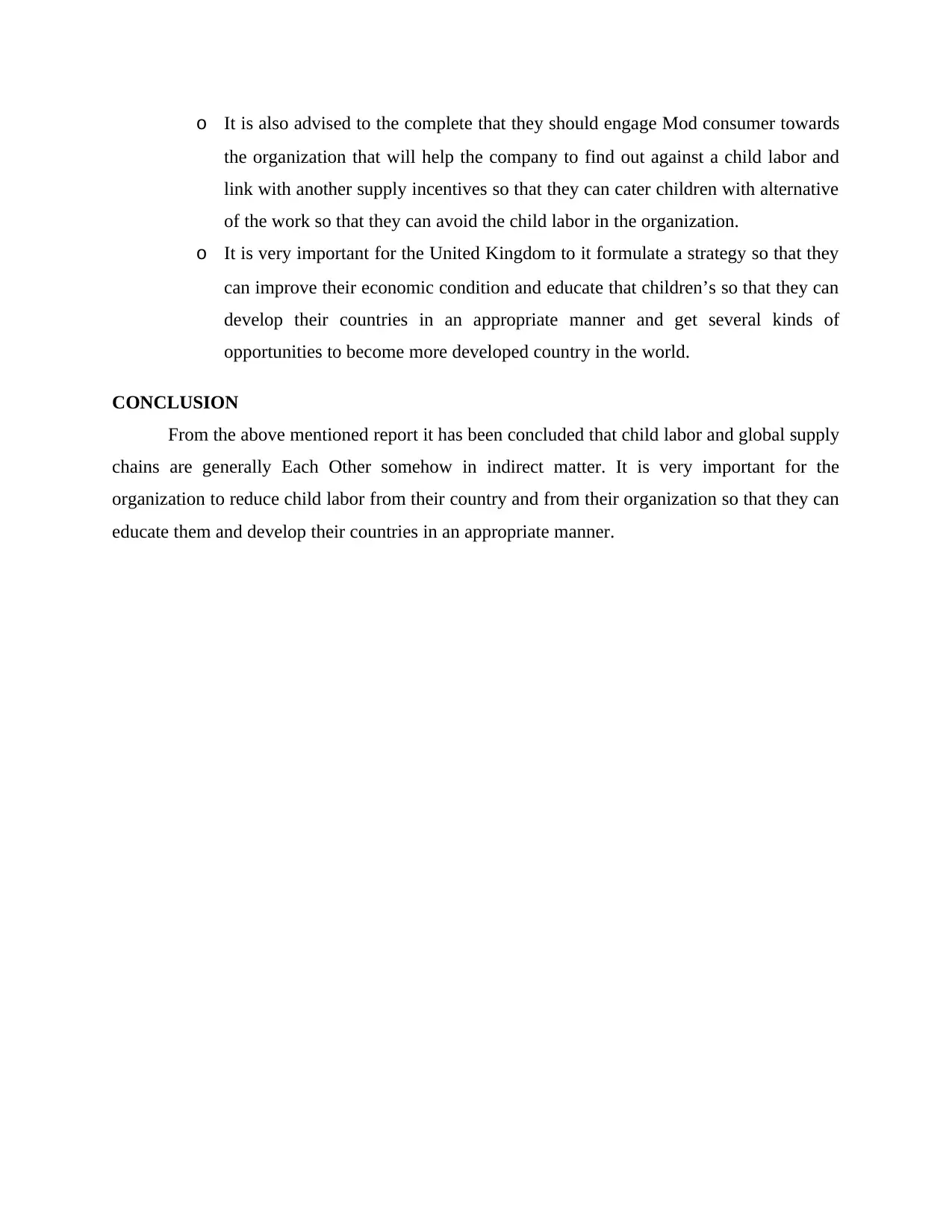
o It is also advised to the complete that they should engage Mod consumer towards
the organization that will help the company to find out against a child labor and
link with another supply incentives so that they can cater children with alternative
of the work so that they can avoid the child labor in the organization.
o It is very important for the United Kingdom to it formulate a strategy so that they
can improve their economic condition and educate that children’s so that they can
develop their countries in an appropriate manner and get several kinds of
opportunities to become more developed country in the world.
CONCLUSION
From the above mentioned report it has been concluded that child labor and global supply
chains are generally Each Other somehow in indirect matter. It is very important for the
organization to reduce child labor from their country and from their organization so that they can
educate them and develop their countries in an appropriate manner.
the organization that will help the company to find out against a child labor and
link with another supply incentives so that they can cater children with alternative
of the work so that they can avoid the child labor in the organization.
o It is very important for the United Kingdom to it formulate a strategy so that they
can improve their economic condition and educate that children’s so that they can
develop their countries in an appropriate manner and get several kinds of
opportunities to become more developed country in the world.
CONCLUSION
From the above mentioned report it has been concluded that child labor and global supply
chains are generally Each Other somehow in indirect matter. It is very important for the
organization to reduce child labor from their country and from their organization so that they can
educate them and develop their countries in an appropriate manner.
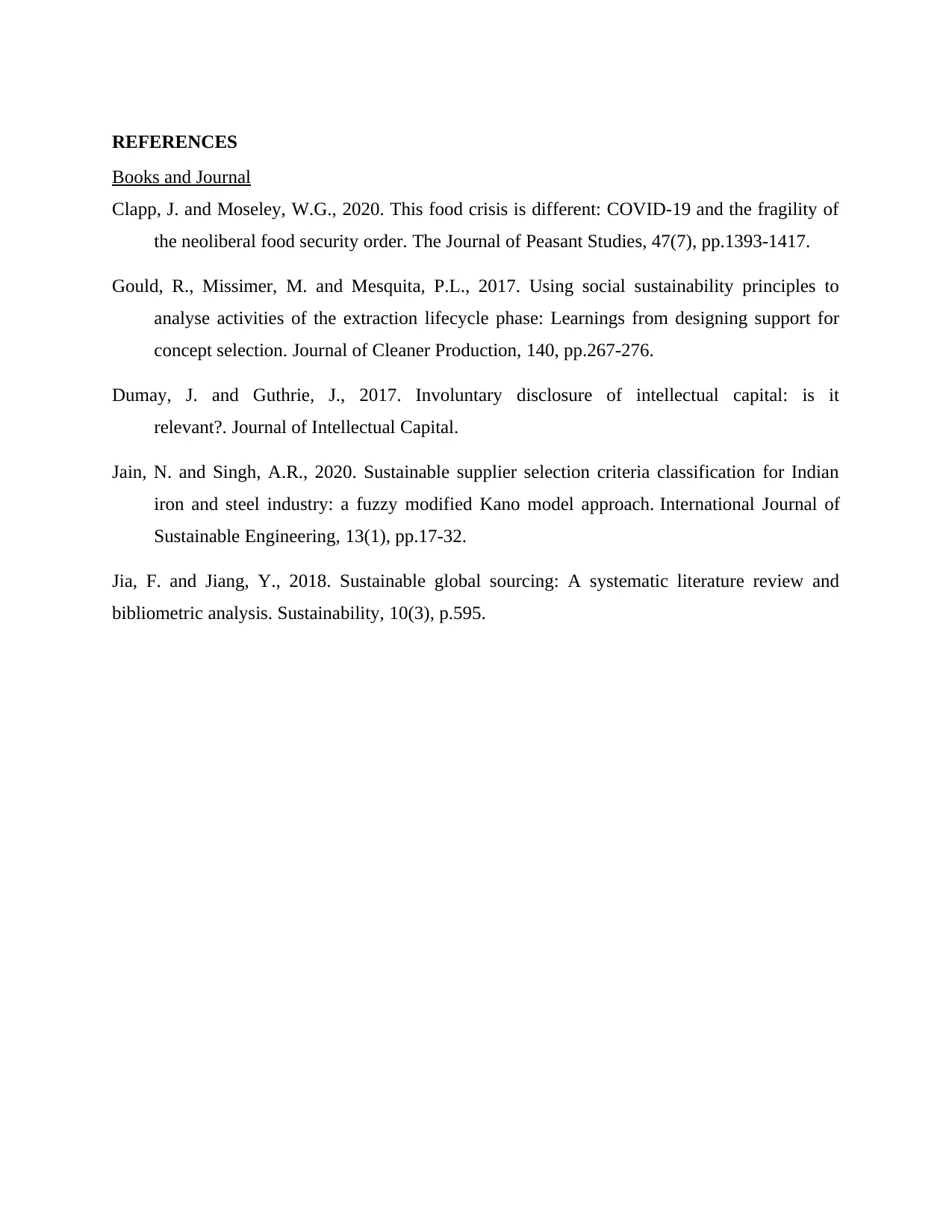
REFERENCES
Books and Journal
Clapp, J. and Moseley, W.G., 2020. This food crisis is different: COVID-19 and the fragility of
the neoliberal food security order. The Journal of Peasant Studies, 47(7), pp.1393-1417.
Gould, R., Missimer, M. and Mesquita, P.L., 2017. Using social sustainability principles to
analyse activities of the extraction lifecycle phase: Learnings from designing support for
concept selection. Journal of Cleaner Production, 140, pp.267-276.
Dumay, J. and Guthrie, J., 2017. Involuntary disclosure of intellectual capital: is it
relevant?. Journal of Intellectual Capital.
Jain, N. and Singh, A.R., 2020. Sustainable supplier selection criteria classification for Indian
iron and steel industry: a fuzzy modified Kano model approach. International Journal of
Sustainable Engineering, 13(1), pp.17-32.
Jia, F. and Jiang, Y., 2018. Sustainable global sourcing: A systematic literature review and
bibliometric analysis. Sustainability, 10(3), p.595.
Books and Journal
Clapp, J. and Moseley, W.G., 2020. This food crisis is different: COVID-19 and the fragility of
the neoliberal food security order. The Journal of Peasant Studies, 47(7), pp.1393-1417.
Gould, R., Missimer, M. and Mesquita, P.L., 2017. Using social sustainability principles to
analyse activities of the extraction lifecycle phase: Learnings from designing support for
concept selection. Journal of Cleaner Production, 140, pp.267-276.
Dumay, J. and Guthrie, J., 2017. Involuntary disclosure of intellectual capital: is it
relevant?. Journal of Intellectual Capital.
Jain, N. and Singh, A.R., 2020. Sustainable supplier selection criteria classification for Indian
iron and steel industry: a fuzzy modified Kano model approach. International Journal of
Sustainable Engineering, 13(1), pp.17-32.
Jia, F. and Jiang, Y., 2018. Sustainable global sourcing: A systematic literature review and
bibliometric analysis. Sustainability, 10(3), p.595.
⊘ This is a preview!⊘
Do you want full access?
Subscribe today to unlock all pages.

Trusted by 1+ million students worldwide
1 out of 6
Related Documents
Your All-in-One AI-Powered Toolkit for Academic Success.
+13062052269
info@desklib.com
Available 24*7 on WhatsApp / Email
![[object Object]](/_next/static/media/star-bottom.7253800d.svg)
Unlock your academic potential
Copyright © 2020–2025 A2Z Services. All Rights Reserved. Developed and managed by ZUCOL.





